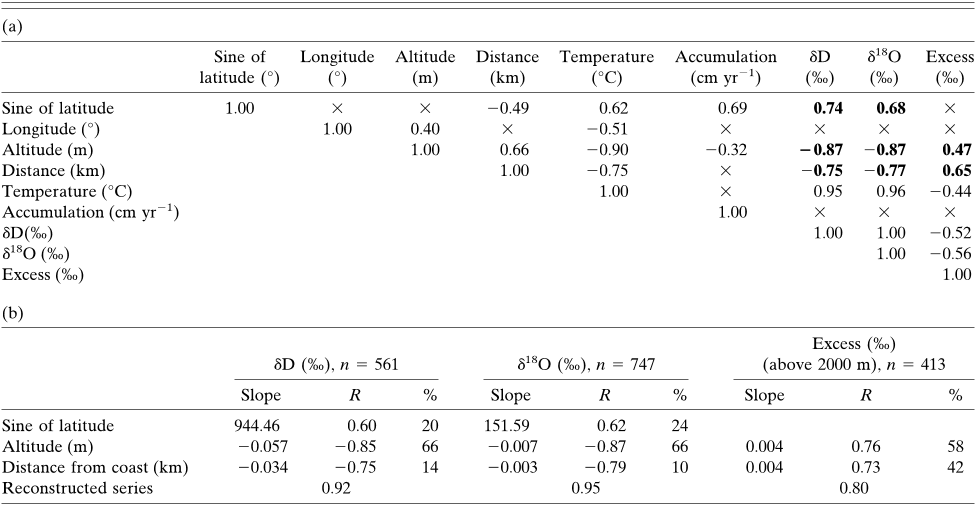




Did you find this useful? Give us your feedback









604 citations
559 citations
489 citations
416 citations
315 citations
99 citations
...A detailed study for Vostok (Ekaykin 2003) confirmed the validity of this assumption for central Antarctica....
[...]
...Caillon, N., J. P. Severinghaus, J. M. Barnola, J. C. Chappellaz, J. Jouzel, and F. Parrenin, 2001: Estimation of temperature change and of gas age ice age difference, 108 kyr B.P., at Vostok, Antarctica....
[...]
...Smaller-than-average isotope–temperature slopes are observed in the central part of West Antarctica, in East Antarctica between Casey and Vostok, and in areas of Dronning Maud Land....
[...]
...Earlier compilations of deuterium excess data (Petit et al. 1991; Dahe et al. 1994) had used the range of variability of deuterium excess measured along pits from Vostok to expand the range of observed values....
[...]
...A number of samples of fresh snow or surface snow exhibit negative deuterium excess data, such as about eight samples from traverses (Dahe et al. 1994; Frezzotti et al. 2005), several samples from Vostok precipitation (Ekaykin et al. 2001; Ekaykin 2003), and many samples from the Dry Valleys (Gooseff et al. 2006)....
[...]
97 citations
...A detailed study for Vostok (Ekaykin 2003) confirmed the validity of this assumption for central Antarctica....
[...]
...Caillon, N., J. P. Severinghaus, J. M. Barnola, J. C. Chappellaz, J. Jouzel, and F. Parrenin, 2001: Estimation of temperature change and of gas age ice age difference, 108 kyr B.P., at Vostok, Antarctica....
[...]
...Smaller-than-average isotope–temperature slopes are observed in the central part of West Antarctica, in East Antarctica between Casey and Vostok, and in areas of Dronning Maud Land....
[...]
...Earlier compilations of deuterium excess data (Petit et al. 1991; Dahe et al. 1994) had used the range of variability of deuterium excess measured along pits from Vostok to expand the range of observed values....
[...]
...A number of samples of fresh snow or surface snow exhibit negative deuterium excess data, such as about eight samples from traverses (Dahe et al. 1994; Frezzotti et al. 2005), several samples from Vostok precipitation (Ekaykin et al. 2001; Ekaykin 2003), and many samples from the Dry Valleys (Gooseff et al. 2006)....
[...]
96 citations
...Earlier modeling studies had also suggested that water evaporated from sea ice–covered oceans could provide very low deuterium excess snowfall at coastal locations (Noone and Simmonds 2004)....
[...]
96 citations
...Sensitivity tests conducted with distillation models suggest that spatial variations of deuterium excess in Antarctica may reflect, at least partly, different moisture origins (Ciais and Jouzel 1994; Ciais et al. 1995; Kavanaugh and Cuffey 2003; Masson-Delmotte et al. 2004)....
[...]
96 citations
...Moreover, seasonal vertical temperature profile observations point to very large variations of inversion strength (Connolley 1996)....
[...]
...…is 0.65, in fair agreement with the 0.67 slope suggested by either Jouzel and Merlivat (1984) or recent syntheses of Antarctic observations (Connolley 1996) between inversion and surface temperature; however, there is a systematic offset, with condensation temperature being higher than the…...
[...]
...67 slope suggested by either Jouzel and Merlivat (1984) or recent syntheses of Antarctic observations (Connolley 1996) between inversion and surface temperature; however, there is a systematic offset, with condensation temperature being higher than the inversion temperature....
[...]